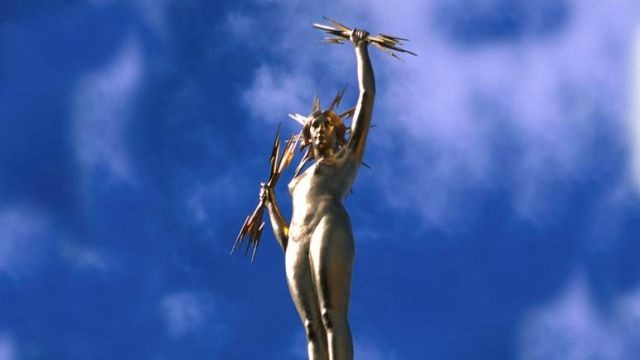Electra statue turns 90 years old, remains Birmingham beacon

Alabama Power customers will receive a credit in October because the company's fuel expenses have been lower this year. The amount of the credit is based on energy use and will be $25 for the typical customer. The Alabama Public Service Commission approved the credit Tuesday. (file)
On May 10, 1926, a new statue was raised to grace the skyline of Birmingham.
New York sculptor Edward Field Sanford Jr.’s “The Divinity of Light” was, after much difficulty, anchored securely atop the newly constructed Alabama Power Company General Office Building. “Miss Electra,” as she soon came to be called, became the talk of the town.
The building where Electra was installed was itself considered a work of art. The design was a departure from Birmingham’s existing skyscrapers. Architects Warren, Knight & Davis drew from the new art deco architectural style, which was becoming popular throughout the country. This style made use of geometrically determined patterns and vertical lines. The shape of the new building narrowed as it rose through a series of step-backs ending in a sloped roof.
 Another design element of the building, which was common to the art deco style, was the use of sculpture and statuary as part of the design. Drawing from Greek, Renaissance and Mezzo American art forms, art deco celebrated the classic nude form.
Another design element of the building, which was common to the art deco style, was the use of sculpture and statuary as part of the design. Drawing from Greek, Renaissance and Mezzo American art forms, art deco celebrated the classic nude form.
The use of these artistic forms made the Alabama Power building the earliest example of art deco design in Birmingham and one of the earliest in the United States.
A symbol of “the state of Alabama rising triumphantly in her electrical progress.”
Sanford also designed the three 8-foot-tall figures depicting Power, Light and Heat above the entrance of the new building. But it was Electra, the nude, gilded bronze female figure surmounting the peak of the sloped roof, that became a sensation. Standing 23 feet tall and holding lightning bolts in her hands with lightning projecting from her hair, Electra was an impressive figure.
In the July 1925 Powergrams, Sanford said it was his intent to create a symbol of “the state of Alabama rising triumphantly in her electrical progress.” At first, the statue was called “The Divinity of Light” but gradually it became known as “Electra.”
Placement of the statue atop the new building, rather than the large electric sign that was originally planned, was due to the persuasive efforts of architect William T. Warren. He argued to the company board of directors that even though there would, no doubt, be some controversy over a nude statue, it “would be a thing of beauty to be looked at and enjoyed over and over again and that it would stand for the ideals of a great company.” The board unanimously agreed and Electra helped establish a progressive corporate identity that has endured.
Electra was such a popular figure in Birmingham that she became the subject of a romantic cartoon satire published in serial form by the Birmingham Post newspaper – “The Love Story of Vulcan and Electra.” This cartoon satire depicted the after-dark romantic adventures of Vulcan and Electra as they frolicked around the state, always having to return to their perches by dawn.
In 1986, as the new Alabama Power Corporate Tower was nearing completion, executives decided to commission a marble replica of “Electra” to be placed on a pedestal in the atrium. After an exhaustive search, Andrew Wielawski, an American sculptor living and working in Carrara, Italy, was selected to create the new Electra. The statue was sculpted from a 1-ton vein of pure white statuario marble from the same quarry used by Michelangelo. The base was carved from polished Chinese black marble in which small sea fossils can be seen if viewed close-up. The project took a year to complete.
On July 22, 1988, the new Electra arrived at Corporate Headquarters and was viewed by President Joseph Farley and other executives. They were extremely pleased and approved its placement in the atrium. Three days later, Electra was officially presented to all employees and the public.
The marble Electra as she stands inside Corporate Headquarters is a link between the old and the new. A true work of art, she connects the 1925 General Office Building with the 1986 Corporate Tower and proudly identifies Alabama Power as the company that has electrified the state for 110 years.
A new exhibit May 19-Aug. 19 in the Alabama Power Museum – “Electra: The Divinity of Light: 1926-2016” – features photographs, historical stories and original art by Alabama artists.





